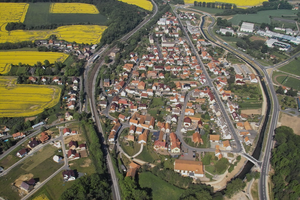Hermannsplatz: Difference between revisions
No edit summary |
mNo edit summary |
||
| Line 4: | Line 4: | ||
Founded in {{AN|1725}} by the [[United Principalities of Cibola]], '''Hermannsplatz''' is a small village and locality which primarily serves as an outpost station for the [[Weisenburger Kriegstruppen]]. It is named after Kriegstruppen ''{{tooltip|Hauptmann|Captain}}'' Hermann Seck, who died during the first military expedition to the city when a [[ESB-Kosaken Afzælt|Cossack band]]<ref>Attributed by sources within the government of the neighbouring [[Principality of Whales]] to rogue cossacks, engaged in an unsanctioned [[razzia]].</ref> ambushed his squad. | Founded in {{AN|1725}} by the [[United Principalities of Cibola]], '''Hermannsplatz''' is a small village and locality which primarily serves as an outpost station for the [[Weisenburger Kriegstruppen]]. It is named after Kriegstruppen ''{{tooltip|Hauptmann|Captain}}'' Hermann Seck, who died during the first military expedition to the city when a [[ESB-Kosaken Afzælt|Cossack band]]<ref>Attributed by sources within the government of the neighbouring [[Principality of Whales]] to rogue cossacks, engaged in an unsanctioned [[razzia]].</ref> ambushed his squad. | ||
The village was built on top of the ruins of the city of [[Hamstadt]], the former capital of [[Zandarijn]]. Left in a ruinous state after the [[Sack of Hamstadt|1699 sacking]] of the city and the collapse of [[Lanzerwald]], laborers from the [[Nationalerarbeitsdienst]] worked to clear the ruins. | The village was built on top of the ruins of the city of [[Hamstadt]], the former capital of [[Zandarijn]]. Left in a ruinous state after the [[Sack of Hamstadt|1699 sacking]] of the city and the collapse of [[Lanzerwald]], laborers from the [[Nationalerarbeitsdienst]] worked to clear the ruins. Although original plans for the area detailed the construction of an extensive military complex and frontier waystation, these plans were abandoned as the cost of the project were said to be unrealistic for the young nation's economic situation (projections stated that the project would not be completed until sometime in the mid-{{AN|1740}}s). Thus, some of the most experienced planners came together and began planning the construction of what they called the "Neuesstadt Hermannsplatz". | ||
Very few historic buildings survived the several destructions of the city and the subsequent cleanup operations. The bomb-ravaged ruins of the [[ZandArena]], once upon a time home to the [[2013 FMF World Cup#Final|2013 FMF World Cup Final]], was pulled down with its grounds being replanted with trees and other foliage. The old city hall also remained in a semi-ruinous state, serving as an artillery storage depot for a short period before being restored. It currently serves as the headquarters for the locality's Chamber of Commerce (Handelskammer) | Very few historic buildings survived the several destructions of the city and the subsequent cleanup operations. The bomb-ravaged ruins of the [[ZandArena]], once upon a time home to the [[2013 FMF World Cup#Final|2013 FMF World Cup Final]], was pulled down with its grounds being replanted with trees and other foliage. The old city hall also remained in a semi-ruinous state, serving as an artillery storage depot for a short period before being restored. It currently serves as the headquarters for the locality's Chamber of Commerce (Handelskammer) | ||
Revision as of 18:00, 14 November 2023

Founded in 1725 AN by the United Principalities of Cibola, Hermannsplatz is a small village and locality which primarily serves as an outpost station for the Weisenburger Kriegstruppen. It is named after Kriegstruppen Hauptmann Hermann Seck, who died during the first military expedition to the city when a Cossack band[1] ambushed his squad.
The village was built on top of the ruins of the city of Hamstadt, the former capital of Zandarijn. Left in a ruinous state after the 1699 sacking of the city and the collapse of Lanzerwald, laborers from the Nationalerarbeitsdienst worked to clear the ruins. Although original plans for the area detailed the construction of an extensive military complex and frontier waystation, these plans were abandoned as the cost of the project were said to be unrealistic for the young nation's economic situation (projections stated that the project would not be completed until sometime in the mid-1740 ANs). Thus, some of the most experienced planners came together and began planning the construction of what they called the "Neuesstadt Hermannsplatz".
Very few historic buildings survived the several destructions of the city and the subsequent cleanup operations. The bomb-ravaged ruins of the ZandArena, once upon a time home to the 2013 FMF World Cup Final, was pulled down with its grounds being replanted with trees and other foliage. The old city hall also remained in a semi-ruinous state, serving as an artillery storage depot for a short period before being restored. It currently serves as the headquarters for the locality's Chamber of Commerce (Handelskammer)
Although still called Hamstadt by some of the locals who remained through the destruction of the original city, it has become the United Principalities' foremost Modellstadt, or Model Town. A new cultural identity has began to be fostered, with many young families moving to the area to seeking a picturesque lifestyle in the countryside.
Notes
- ^ Attributed by sources within the government of the neighbouring Principality of Whales to rogue cossacks, engaged in an unsanctioned razzia.